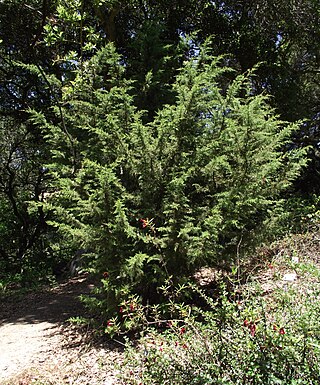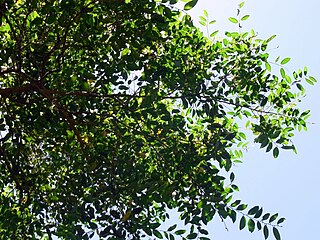
Podocarpus totara (; the tōtara is a species of podocarp tree endemic to New Zealand. It grows throughout the North Island, South Island and rarely on Stewart Island / Rakiura in lowland, montane and lower subalpine forest at elevations of up to 600 m.

Antidesma is a genus of tropical plant in the family Phyllanthaceae formally described by Linnaeus in 1753. It is native to tropical Africa, S + E + SE Asia, Australia, and various oceanic islands. The greatest diversity occurs in Southeast Asia.

Hesperocyparis arizonica, the Arizona cypress, is a North American species of tree in the cypress family Cupressaceae, native to the southwestern United States and Mexico. Populations may be scattered rather than in large, dense stands.

Hesperocyparis bakeri, previously known Cupressus bakeri, with the common names Baker cypress, Modoc cypress, or Siskiyou cypress, is a rare species of western cypress tree endemic to a small area across far northern California and extreme southwestern Oregon, in the western United States.

Hesperocyparis goveniana commonly known as Californian cypress and Gowen cypress, is a species of western cypress that is endemic to a small area of coastal California near Monterey. It was formerly classified as Cupressus goveniana.

Baccaurea is a genus of flowering plants belonging to the family Phyllanthaceae. The genus comprises 51 species, distributed from India to Indochina, southern China, Malesia, New Guinea, and the West Pacific. It is dioecious, with male and female flowers on separate plants. Many species contain edible fruits.

Breynia is a genus in the flowering plant family Phyllanthaceae, first described in 1776. It is native to Southeast Asia, China, Réunion, the Indian Subcontinent, Papuasia and Australia.

Glochidion is a genus of flowering plants, of the family Phyllanthaceae, known as cheese trees or buttonwood in Australia, and leafflower trees in the scientific literature. It comprises about 300 species, distributed from Madagascar to the Pacific Islands. Glochidion species are used as food plants by the larvae of some Lepidoptera species including Aenetus eximia and Endoclita damor. The Nicobarese people have attested to the medicinal properties found in G. calocarpum, saying that its bark and seed are most effective in curing abdominal disorders associated with amoebiasis.

Lagerstroemia subcostata, the Taiwan crepe myrtle, is a deciduous tree native to Japan, the Ryukyu Islands, Taiwan, and southern China, and introduced to the Philippines.

Canarium zeylanicum is a species of flowering plant in the frankincense family, Burseraceae, that is endemic to Sri Lanka. Canarium zeylanicum is a large branched tree that can grow up to 25–30m in height. The seeds of this plant are large, oval, and they can be eaten. This plant can be seen with fruits and flowers in the months of April to September. The oil of the seeds of Canarium zeylanicum are edible and this oil has been used by Sri Lankans for medicinal purposes and for food for ages. However, these uses of the plant are confined to its rural population and even then, they mostly use it for traditional medicinal purposes. Over 95% of the seeds produced and harvested from these plants are thrown away, wasting its source of valuable, natural, and nutritional value.

Glochidion candolleanum is a species of flowering plant in the family Phyllanthaceae. It is a tree native to Sri Lanka and southern India.
Glochidion zeylanicum var. tomentosum is a variety of flowering plant in the family Phyllanthaceae. It is native to tropical and subtropical Asia, ranging from India and Sri Lanka to the Himalayas, Myanmar, Thailand, and southern China to Taiwan and the Ryukyu Islands.
Breynia assimilis is an extremely rare species of flowering plant in the family Phyllanthaceae. It is a shrub or tree endemic to the wet evergreen lowland forests of southwestern Sri Lanka. It is only known from the Sinharaja Biosphere Reserve there, evidence of its existence was last catalogued before 1991, and it has not been found since then. It may since have become extinct.

Hesperocyparis stephensonii is a species of western cypress known as the Cuyamaca cypress that is found only in two very small areas in Southern California and northwestern Baja California.

Glochidion sumatranum known as the umbrella cheese tree is a plant in the family Phyllanthaceae. Although recognized as a distinct species by some sources, others include it within Glochidion zeylanicum. It is found in northern and eastern Australia, New Guinea and Indonesia. The habitat is rainforest, or rainforest margins in swampy areas, sometimes associated with palms. It may grow to 15 metres tall. The most southerly point of natural distribution is Iluka, New South Wales.

Terminalia pendula is an Asian species of tree in the family Combretaceae. It is a medium-sized tree found in both primary and secondary tropical and sub-tropical forests. It is recorded from India to China, south to Thailand and Vietnam. It may be one of the dominant species of seasonal tropical forests of Vietnam. In Yunnan it is found in rocky limestone areas, near sea level to 700 m (2,300 ft). Besides timber uses, the bark of this species has a high tannin content.
Excoecaria cuspidata is a species of flowering plant in the family Euphorbiaceae. It was originally described as Excoecaria hialayensis var. cuspidataMüll.Arg. It is native to China and Meghalaya, India.

Hippocratea is a genus of flowering plants in the family Celastraceae, usually lianas, native to tropical and subtropical North America, South America and Africa.

Phalaenopsis difformis, also known as the dark brown Phalaenopsis, is a species of epiphytic orchid native to Assam, Borneo, China South-Central, China Southeast, East Himalaya, Laos, Malaya, Myanmar, Bangladesh, Nepal, Sumatera, Thailand, Vietnam and West Himalaya.
















